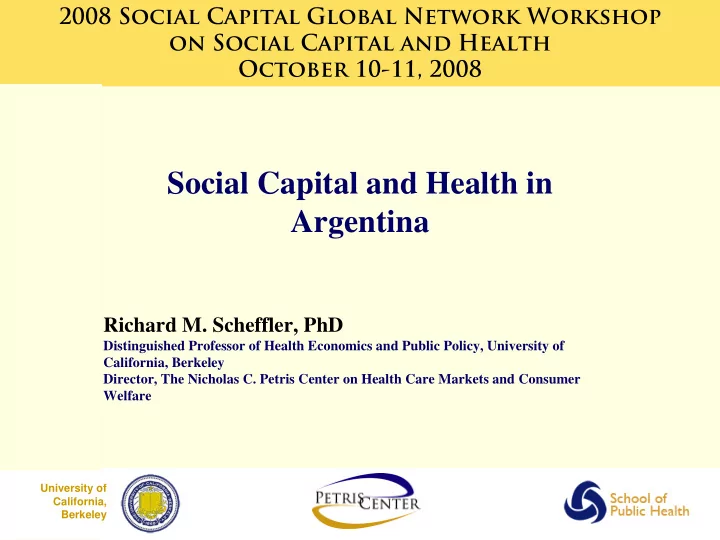

2008 Social Capital Global Network Workshop on Social Capital and Health October 10-11, 2008 This Social Capital and Health in Argentina Richard M. Scheffler, PhD Distinguished Professor of Health Economics and Public Policy, University of California, Berkeley Director, The Nicholas C. Petris Center on Health Care Markets and Consumer Welfare test University of California, Berkeley
2008 Social Capital Global Network Workshop on Social Capital and Health October 10-11, 2008 This Lucas Ronconi, PhD Post-Doctoral Fellow, UC Berkeley Labor Center Timothy T. Brown, PhD Assistant Adjunct Professor of Health Economics, School of Public Health, University of California at Berkeley Associate Director of Research and Training, The Nicholas C. Petris Center on Health Care Markets and Consumer Welfare test University of California, Berkeley
Data and Measurement � Encuesta Desarrollo Social � 1997 Argentine Household survey � Covers all 24 provinces � Approximately 59,000 people � Sample: Aged 65+ years � Approximately 9.6% of the population � 5,645 people
Data and Measurement: Health Status � Health Status � Do you have health problems? � 1 if any health problems (self-report) � 0 if no health problems (self-report
Data and Measurement: Social Capital � Associational involvement : � Number of groups respondent involved in (11 possible groups : 0-11) � Sports club � Human rights group � Political party � Ecological organization � Church � Neighborhood � Cultural center association � Labor union � School cooperative � Nationality group � Solidarity association
Data and Measurement: Social Capital � Informal social interactions � Index based on 3 factors � Often meets with friends � Often meets with relatives � Person is alone � Index construction, � Standardize each response: subtract the mean and then divide by the standard deviation � Sum the first two factors and subtract the third.
Descriptive Statistics Variable Mean Std dev Min Max Age 73.126 6.555 65 98 Sex (male=1) 0.409 0.492 0 1 Years of schooling 6.189 4.049 0 17 Income per capita (pesos per month) 345.8 408.4 0 6700 Health problems (yes=1) 0.500 0.500 0 1 Informal social interactions (index) 6.28E-08 1.867 -5.17 2.86 Associational involvement (counts) 0.425 0.845 0 11 5,645 observations
Methodology � (1) H i = β SC i + δ Z i + ε i H i is health status of individual i , SC is social capital (formal and informal), Z includes age, sex, education, income per capita, and marital status
Econometric Issues � Endogeneity � More health problems less participation in formal groups and informal groups � Omitted variables � Omitted factors affecting health may correlate with SC � Solve with exogenous instrumental variable � Lack of Public Transportation in the Neighborhood � 1 if lack of public transportation � 0 if no lack of public transportation
First-Stage Estimates DV=Informal social DV= Associational interactions involvement std Coef. error Coef. std err Lack of public transportation -0.597*** 0.089 0.054 0.041 ** p ≤ 0.01 • 5,645 observations • Includes province fixed effects, age, sex, education, income per capita, and marital status • The instrument only passes the Stock-Yogo test (strength test) for informal social interactions
Second-Stage Estimates Coef std error Informal social interactions (index) -0.920** 0.167 Age -0.014* 0.007 Male -0.072 0.058 Divorced -0.465** 0.172 Widowed -0.276** 0.081 Unmarried -0.884** 0.188 No response (marital status) 0.881 0.831 Years of schooling -0.001 0.009 Income per capita (pesos per month) 0.00001 0.00008 Individuals in the reference group are female and married ** p ≤ 0.01, * p ≤ 0.05 • 5,645 observations • All regression models include province fixed effects
Conclusion � Individual social capital (informal social interactions) � Positively associated with health status � Causally associated with health status (IV)
Recommend
More recommend